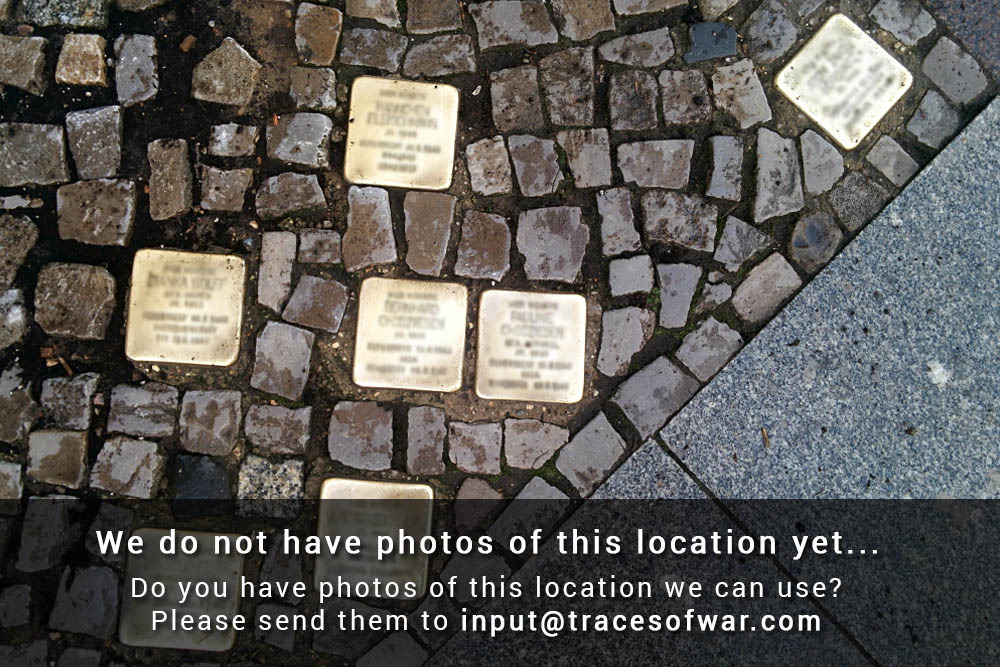Stumbling Stones Liebfrauenstraße 38
These small, brass, memorial plaques (Stolpersteine or stumbling stones) commemorate:
*Fritz Rahkob, born 1885, arrested 1943, ‘preparing for treason,’ Gelsenkirchen Police Jail, Stadelheim Prison in Munich, murdered 24 August 1944, Remand Prison, Stuttgart.
* Rudolf Littek, born 1890, in resistance, arrested 1943, Gelsenkirchen Prison, 1945 Neuengamme, M.S. Thielbeck, dead 3 May 1945, Neustädter Bucht.
Fritz Rahkob joined the resistance group of Franz Zielasko. The group was betrayed, and in August 1943 almost 50 anti-fascists were arrested, including Fritz Rahkob. The leader, Zielasko, was tortured to death. The others were given the death sentence. Fritz Rahkob was guillotined on 24 August 1944. The Nazis kept his body. His wife Emma was arrested on the same day and scheduled for deportation to a concentration camp, but later the Allies freed her from the Munich Police Prison. Finally in 1947 Frita Rahkob’s body was cremated and buried.
In 1987, a town square was named for him: Fritz-Rahkob-Platz is located at Munkelstrasse and Eberstrasse. The stolpersteine for him at this address was installed in August 2011.
Rudolf Littek, a soldier in World War I, married Anna Muhlack in 1919. They had two children, one of whom died soon after birth. Rudolf worked as a driver in the Ruhr area and soon connected with the area labor movement. He joined the communist party in 1921, and in 1928 he represented them on the Gelsenkirchen City Council. He was arrested in August 1943 with the Zielasko resistance group. In a trial by the Volksgerichtshof (people’s court), he was acquitted but not released. He was moved from Gelsenkirchen prison, to a re-education labor camp near Petershagen an der Weser, and then in 1945 to Neuengamme camp.
When the Nazis emptied the Neuengamme camp in April 1945 before the arrival of the Allies, thousands of prisoners were put on the Cap Arcona and the Thielbeck, ships which became overcrowded concentration camps with no food and no drinking water. These floating concentration camps were hidden in plain sight among other troop ships. With a goal of keeping the Germans from escaping by boat, the British bombed the ships in the harbor. Approximately 7,000 concentration camp prisoners died by fire or drowning, or were shot by Germans on the shore. Rudolf Littek was on the Thielbeck. Four days later, the Germans signed an unconditional surrender of all German forces to the Allies.
For more information and photos about the Cap Arcona, please see Floating concentration camps in the Bay of Lübeck.
"Stolpersteine" is an art project for Europe by Gunter Demnig to commemorate victims of National Socialism (Nazism). Stolpersteine (stumbling stones) are small, 10x10cm brass plaques placed in the pavement in front of the last voluntary residence of (mostly Jewish) victims who were murdered by the Nazis. Each plaque is engraved with the victim’s name, date of birth, and place (mostly a concentration camp) and date of death. By doing this, Gunter Demnig gives an individual memorial to each victim. One stone, one name, one person. He cites the Talmud: "A human being is forgotten only when his or her name is forgotten."
For more information and pictures, please visit Stolpersteine Gelsenkirchen (in German).
Do you have more information about this location? Inform us!
Source
- Text: Fedor de Vries & Anne Palmer
- Photos: TracesOfWar.com
- Stolpersteine Gelsenkirchen: Fritz Rahkob
- Stolpersteine Gelsenkirchen: Rudolf Littek
- Stolpersteine.eu
Nearby
Museum
Point of interest
- Air-Raid Shelter Günnigfelder Straße - Bochum
- Air Raid Shelter Gertrudisplatz - Bochum-Wattenscheid
- Air Raid Shelter Marienstraße - Bochum-Wattenscheid
Monument
- Memorial Crew Lancaster III LM327 - Gelsenkirchen
- Bismarck-tower Essen - Essen
- Statue of Emperor William I - Essen
Cemetery
- German War Graves Günnigfeld - Günnigfeld
- German War Graves Wanne-Eickel - Wanne-Eickel
- German War Graves Hordel - Hordel




